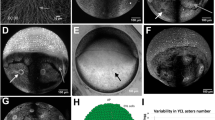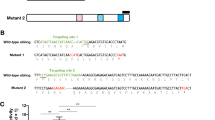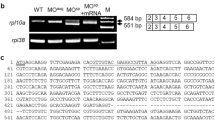Abstract
Embryonic cell movement is essential for morphogenesis and the establishment of body shapes1,2, but little is known about its mechanism. Here we report that pregnenolone, which is produced from cholesterol by the steroidogenic enzyme Cyp11a1 (cholesterol side-chain cleavage enzyme, P450scc)3, functions in promoting cell migration during epiboly. Epiboly is a process in which embryonic cells spread from the animal pole to cover the underlying yolk. During epiboly, cyp11a1 is expressed in an extra-embryonic yolk syncytial layer4. Reducing cyp11a1 expression in zebrafish using antisense morpholino oligonucleotides did not perturb cell fates, but caused epibolic delay. This epibolic defect was partially rescued by the injection of cyp11a1 RNA or the supplementation of pregnenolone. We show that the epibolic delay is accompanied by a decrease in the level of polymerized microtubules, and that pregnenolone can rescue this microtubule defect. Our results indicate that pregnenolone preserves microtubule abundance and promotes cell movement during epiboly.
This is a preview of subscription content, access via your institution
Access options
Subscribe to this journal
Receive 51 print issues and online access
$199.00 per year
only $3.90 per issue
Buy this article
- Purchase on Springer Link
- Instant access to full article PDF
Prices may be subject to local taxes which are calculated during checkout




Similar content being viewed by others
References
Locascio, A. & Nieto, M. A. Cell movements during vertebrate development: integrated tissue behaviour versus individual cell migration. Curr. Opin. Genet. Dev. 11, 464–469 (2001)
Myers, D. C., Sepich, D. S. & Solnica-Krezel, L. Convergence and extension in vertebrate gastrulae: cell movements according to or in search of identity? Trends Genet. 18, 447–455 (2002)
Miller, W. L. Molecular biology of steroid hormone synthesis. Endocr. Rev. 9, 295–318 (1988)
Hsu, H. J., Hsiao, P., Kuo, M. W. & Chung, B. C. Expression of zebrafish cyp11a1 as a maternal transcript and in yolk syncytial layer. Gene Expr. Patterns 2, 219–222 (2002)
Chen, S. & Kimelman, D. The role of the yolk syncytial layer in germ layer patterning in zebrafish. Development 127, 4681–4689 (2000)
Babin, P. J. et al. Both apolipoprotein E and A-I genes are present in a nonmammalian vertebrate and are highly expressed during embryonic development. Proc. Natl. Acad. Sci. USA 94, 8622–8627 (1997)
Sharma, M. K. et al. Sequence, linkage mapping and early developmental expression of the intestinal-type fatty acid-binding protein gene (fabp2) from zebrafish (Danio rerio). Comp. Biochem. Physiol. B Biochem. Mol. Biol. 138, 391–398 (2004)
Grigoryev, D. N. et al. Cytochrome P450c17-expressing Escherichia coli as a first-step screening system for 17α-hydroxylase-C17,20-lyase inhibitors. Anal. Biochem. 267, 319 (1999)
Rheaume, E. et al. Structure and expression of a new complementary DNA encoding the almost exclusive 3 beta-hydroxysteroid dehydrogenase/delta 5-delta 4-isomerase in human adrenals and gonads. Mol. Endocrinol. 5, 1147–1157 (1991)
Jesuthasan, S. & Stahle, U. Dynamic microtubules and specification of the zebrafish embryonic axis. Curr. Biol. 7, 31–42 (1997)
Solnica-Krezel, L. & Driever, W. Microtubule arrays of the zebrafish yolk cell: organization and function during epiboly. Development 120, 2443–2455 (1994)
Strahle, U. & Jesuthasan, S. Ultraviolet irradiation impairs epiboly in zebrafish embryos: evidence for a microtubule-dependent mechanism of epiboly. Development 119, 909–919 (1993)
Akhmanova, A. et al. Clasps are CLIP-115 and -170 associating proteins involved in the regional regulation of microtubule dynamics in motile fibroblasts. Cell 104, 923–935 (2001)
Liu, L., Tommasi, S., Lee, D. H., Dammann, R. & Pfeifer, G. P. Control of microtubule stability by the RASSF1A tumour suppressor. Oncogene 22, 8125–8136 (2003)
Dent, E. W. & Gertler, F. B. Cytoskeletal dynamics and transport in growth cone motility and axon guidance. Neuron 40, 209–227 (2003)
Watanabe, T., Noritake, J. & Kaibuchi, K. Regulation of microtubules in cell migration. Trends Cell Biol. 15, 76–83 (2005)
Morris, N. R. Nuclear positioning: the means is at the ends. Curr. Opin. Cell Biol. 15, 54–59 (2003)
Wittmann, T., Hyman, A. & Desai, A. The spindle: a dynamic assembly of microtubules and motors. Nature Cell Biol. 3, E28–E34 (2001)
Murakami, K., Fellous, A., Baulieu, E. E. & Robel, P. Pregnenolone binds to microtubule-associated protein 2 and stimulates microtubule assembly. Proc. Natl Acad. Sci. USA 97, 3579–3584 (2000)
D'Amico, L. A. & Cooper, M. S. Morphogenetic domains in the yolk syncytial layer of axiating zebrafish embryos. Dev. Dyn. 222, 611–624 (2001)
Arensburg, J., Payne, A. H. & Orly, J. Expression of steroidogenic genes in maternal and extraembryonic cells during early pregnancy in mice. Endocrinology 140, 5220–5232 (1999)
Hu, M. C. et al. Steroid deficiency syndromes in mice with targeted disruption of Cyp11a1. Mol. Endocrinol. 16, 1943–1950 (2002)
Venihaki, M., Carrigan, A., Dikkes, P. & Majzoub, J. A. Circadian rise in maternal glucocorticoid prevents pulmonary dysplasia in fetal mice with adrenal insufficiency. Proc. Natl. Acad. Sci. USA 97, 7336–7341 (2000)
Kozlova, T. & Thummel, C. S. Essential roles for ecdysone signaling during Drosophila mid-embryonic development. Science 301, 1911–1914 (2003)
Cato, A. C., Nestl, A. & Mink, S. Rapid actions of steroid receptors in cellular signaling pathways. Sci. STKE 2002, RE9 (2002)
Schmidt, B. M. et al. Rapid, nongenomic steroid actions: A new age? Front. Neuroendocrinol. 21, 57–94 (2000)
Chiang, E. F. et al. Two sox9 genes on duplicated zebrafish chromosomes: expression of similar transcription activators in distinct sites. Dev. Biol. 231, 149–163 (2001)
Gard, D. L. Organization, nucleation, and acetylation of microtubules in Xenopus laevis oocytes: a study by confocal immunofluorescence microscopy. Dev. Biol. 143, 346–362 (1991)
Acknowledgements
We would like to thank V. Korzh and C.-H. Hu for the plasmids for in situ hybridization, and K. Deen and M. Wyatt for editing the manuscript. This work was supported by grants from the National Science Council and Academia Sinica, Taiwan. Author Contributions H.-J.H. performed all the experiments; M.-R.L. synthesized F–P5; C.-T.C. devised and supervised the F–P5 synthesis scheme; B.-c.C. oversaw the execution of the entire project.
Author information
Authors and Affiliations
Corresponding author
Ethics declarations
Competing interests
Reprints and permissions information is available at npg.nature.com/reprintsandpermissions. The authors declare no competing financial interests.
Supplementary information
Supplementary Figures
This file contains Supplementary Figures 1–9 (PPT 7800 kb)
Supplementary Figure Legends
This file contains text to accompany the above Supplementary Figures. (DOC 37 kb)
Supplementary Table
Reducing cyp11a1 expression resulted in epibolic defect. (DOC 38 kb)
Supplementary Methods
This file details the methods for fish maintenance, morpholinos and analysis of genomic structures, plasmids, microinjection and detection of gene expression, steroid detection, RT-PCR, and synthesis of fluorescein conjugated pregnenolone. (DOC 215 kb)
Rights and permissions
About this article
Cite this article
Hsu, HJ., Liang, MR., Chen, CT. et al. Pregnenolone stabilizes microtubules and promotes zebrafish embryonic cell movement. Nature 439, 480–483 (2006). https://doi.org/10.1038/nature04436
Received:
Accepted:
Issue Date:
DOI: https://doi.org/10.1038/nature04436
This article is cited by
-
Screening of Natural Compounds for CYP11A1 Stimulation Against Cell Renal Cell Carcinoma
Biological Procedures Online (2023)
-
A synthetic pregnenolone analog promotes microtubule dynamics and neural development
Cell & Bioscience (2022)
-
Proof-of-concept randomized controlled trial of pregnenolone in schizophrenia
Psychopharmacology (2014)
-
Structure-activity relationship studies on neuroactive steroids in memory, alcohol and stress-related functions: a crucial benefit from endogenous level analysis
Psychopharmacology (2014)
-
Pregnenolone activates CLIP-170 to promote microtubule growth and cell migration
Nature Chemical Biology (2013)
Comments
By submitting a comment you agree to abide by our Terms and Community Guidelines. If you find something abusive or that does not comply with our terms or guidelines please flag it as inappropriate.



